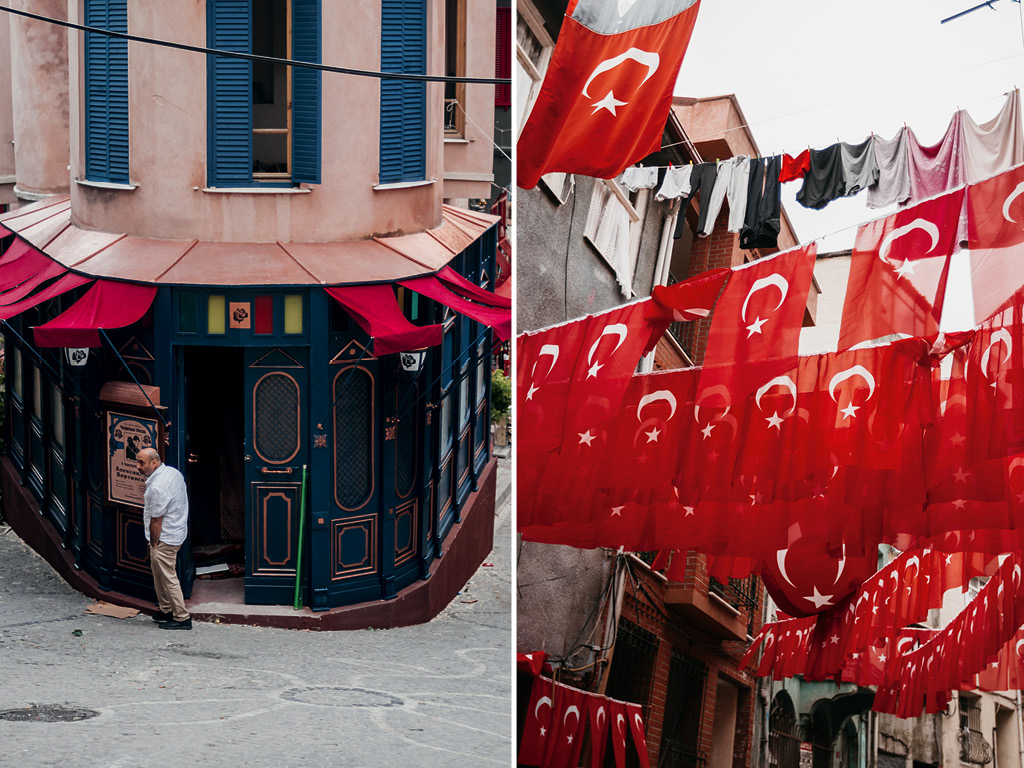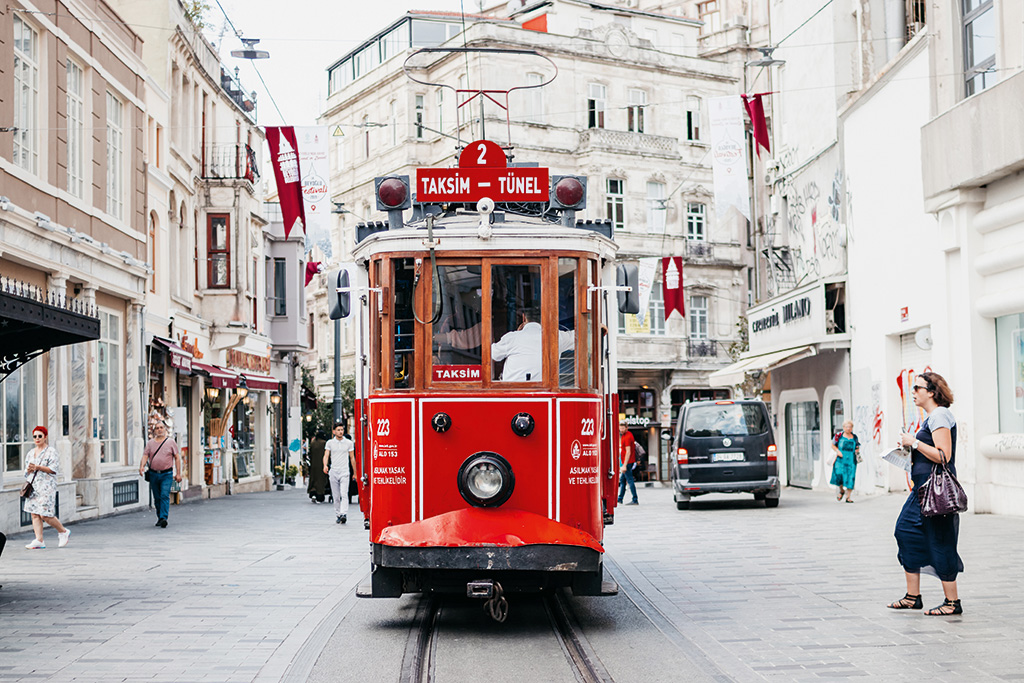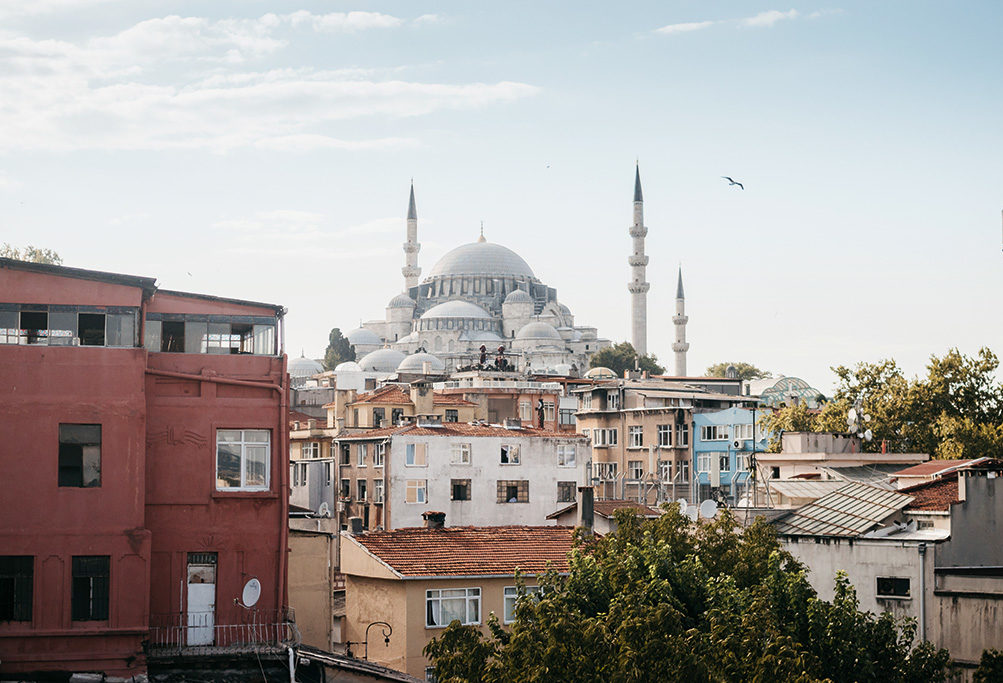You’ll probably never have enough time to fully explore the beguiling streets of Istanbul, but Darrel Bristow-Bovey knows them pretty well. Here is his guide to the city that straddles two worlds.

Some of the oldest and most venerable dessert shops, such as Hafiz Mustafa, are on Istiklal Avenue, selling lokum (Turkish delight) and many honey-nutty pastries. Image credit: Achmat Booley
For 1 ,500 years, everyone has wanted to go to Istanbul. All the Popes and Russian tsars, all the great powers of the West and East, have dreamed of walking her fabled walls. Istanbul is ‘the city of the world’s desire’, the former Byzantium and Constantinople, the only city that has been the capital of three separate empires, the only one to straddle two continents, a gleaming city of domes and towers and green hills and sunlight on blue sea.
You are not a tsar, but you need at least three days in Istanbul, because it is made of layers upon layers that only open up slowly, and the best of it takes time.
Everyone stays in Sultanahmet, the Old Town on the promontory above the Golden Horn (the large, shimmering inlet of the Sea of Marmara), but this may be a mistake. Sultanahmet contains the classic sights – Hagia Sofia, formerly the largest and most beautiful church in Christendom; the Blue Mosque; the Grand Bazaar; Topkapi Palace, former home of the Ottoman sultans. These are wonderful and of course you must visit them, but Sultanahmet itself is touristy and crowded and hot, filled with souvenir tat and backpacker lodges. There are no good restaurants or bars and it’s the least authentic part of modern Istanbul.

You can still find original 19th-century wooden houses and neighbourhood shops selling sherbeti in the Fener district, on the banks of the Golden Horn; Turkish flags flutter amid the laundry – in terms of religion and politics, the Fener district is the most traditional, conservative and patriotic part of the city.Image credit: Achmat Booley
Personally, I base myself in Cihangir (pronounced ‘ji-hun-gear’), a neighbour-hood of Beyoglu on the hill across the Golden Horn, which has always been the most cosmopolitan part of Istanbul. The Cihangir Mosque was built in 1559 to honour a prince, the hunchbacked favourite son of Suleiman the Magnificent, greatest of the Ottomon sultans, and his beloved wife Roxelana. When Vita Sackville-West, former lover of Virginia Woolf, lived in Beyoglu she wrote her poem ‘The Muezzin’ while sitting under a fig tree in the mosque gardens, listening to the call to prayer.
Nearby on Şimşirci Street is my favourite eatery, Demeti. The terrace is small, so be sure to book in advance – there is no better welcome to Istanbul than an evening on the terrace at Demeti with raki and meze, watching the white wakes of the ships on the Sea of Marmara and the green Asian hills across the straits blazing in the slanting sunlight. (The next night, go to Kasabim next door for the tender iskender steak, a regional speciality of Bursa, served in an indescribable tomato-based sauce on bread made from potato flour. The first time I tasted it I cried with happiness.)

Simit are delicious, chewy, sesame-flavoured bread rings eaten for breakfast; the Blue Mosque isn’t blue, but if you squint your eyes and turn your head to one side, the tiles have a bluish tinge. Image credit: Achmat Booley
Running along the top of Beyoglu ridge from the Galata Tower to Taksim Square is Istiklal Caddesi, the pedestrianised street that was once the centre of European high society, where ladies and gents took their promenade amid the clip-clop of carriages and the tinkling of silver bells. It’s a busy shopping street today, buzzing with lights and laughter. Stop for a creamy and elastic Turkish ice-cream from one of the vendors in fezzes, who whip it and stretch it and play the fool with you as they serve it.
One block away on the other side of Istiklal is the Pera Palace Hotel, where Agatha Christie stayed every year. You can visit Room 411 where she wrote Murder on the Orient Express, if it’s not occupied, and ride up in the beautiful wood-panelled elevator that she used. The dry martini in the Orient Bar is mixed with sensitivity and finesse, but if you’re on a budget you’ll have to restrict yourself to one. Two, tops. Okay, three, but then your children can’t go to university.

Turkish coffee is boiled in hot sand (and it’s very strong); the Galata (or Pera) Tower was built by the Genoese in 1348 and used as a watchtower for fires in a city then built largely of wood. Image credit: Achmat Booley
A day of your stay should be dedicated to a boat trip up the Bosphorus, the river of ocean that leads to the Black Sea, with Europe on your left and Asia on your right. Ignore the expensive cruises and catch the ferry from Eminönü docks just before the Galata Bridge on the Sultanahmet side of the Golden Horn. For R65 you can travel all the way to the Black Sea – 90 minutes, past Ottoman castles and stately old wooden waterside mansions and pods of dark Bosphorus dolphins. Disembark in Anadolu Kavagi, the last village before the Black Sea, walk up to the fortress and take a late lunch in a fish restaurant at the waterside.
For a glimpse of dazzling, gold-tiled Byzantium, take the T4 tram from Topkapi or buses from Eminönü or Taksim Square to the Chora Church. The walls and ceiling are covered with breathtaking golden mosaics that blaze in sunlight. Then walk the neighbourhood and climb up the old city walls of Theodosius and stroll back through the traditional neighbourhood of Fener, with its narrow lanes and wooden houses and grandmothers shaking out ancient carpets from their balconies.

The 19th-century tram rattles down the middle of Istiklal Cadessi, clanking its bell to move pedestrians out of the way. Image credit: Achmat Booley
On the hillside below Cihangir, in Çukurcuma, a former working-class area now increasingly hip, is The Museum of Innocence, the extraordinary art project built by Orhan Pamuk with the proceeds of his Nobel Prize for Literature. If you’ve read his novel of the same title – and you should – then you can’t miss it. But even if you haven’t, it’s extraordinarily absorbing, well worth an hour or so, offering a beautifully curated glimpse of Istanbul life in the second half of the 20th century, rendered through the everyday objects of middle-class life. (Free entry if you bring along a copy of the novel.)
Afterwards, wander up the hill to Inci Patisserie – frequently mentioned in the novel – for the best profiteroles in Istanbul. If you like your desserts a little more savoury, head to Özkonak in Cihangir for chicken-breast pudding, which is far more delicious than it sounds.
There’s no compelling reason to go to the swanky areas like Şişli or Nişantaşi – the Sandton of Istanbul – but if you are in Şişli and feeling hungry, try Lahmacun Plus. Sit at a sidewalk table and enjoy a wonderful, inexpensive lahmacun – a Turkish flatbread pizza topped with cheese or meat – and add your own fresh green herbs and chopped onions and a squeeze of lemon.
Istanbul is all minarets and appetite and Ottoman spices and unexpected sights – the sea below you glimpsed through linden trees; an old man riding a bicycle with a monkey on his shoulder. Some of the best times are to be had for free when you’re not looking for them: watching the gulls snatching bait from the fishermen on Galata Bridge; strolling among the tulips in Gulhane Park; sipping pomegranate juice in the courtyard of the Süleymaniye Mosque. I have visited Istanbul 15 times and keep going back. A local legend says when the rest of the world ends, Constantinople will still stand, golden and eternal. I hope that’s true.

Plan your trip
Getting There
Turkish Airlines flies to Istanbul from Joburg and Cape Town for about R6 ,995. turkishairlines.com
Also look at prices on Qatar Airways, Etihad, Emirates and Ethiopian Airlines.
Getting There
Explore neighbourhoods on foot, but to get between them you have many options, from buses and trams to a metro and ferries. Get an Istanbulkart (R25) from the yellow machines at stations or at street kiosks, and load it with cash. You’ll pay R7 per trip.
Best time to go
It’s extremely hot in summer and icy cold in winter, all through April (spring) when the winds still sweep down the Bosphorus from Russia. On the other hand, when it snows in Istanbul it is a fairy tale.
Need to Know
Vendors in the Grand Bazaar will be very disappointed if you don’t haggle with them. Expect a good, long, sociable session including raki or tea. Currently the Turkish lira is worth R2,60 so Istanbul is a bargain.
The cost of a carpet or a leather jacket depends on your bargaining skills, but restaurant prices are about 60% cheaper than Cape Town. Five dishes for two people at Demeti, for example, will cost around R280. Imported alcohol is expensive, but with delicious Turkish beer and wine at hand, this is a matter of complete irrelevance.

There is always a fresh juice to be had on virtually every street corner, squeezed in front of you using a heavy, iron, screw-operated press. My favourite is pomegranate, in spring. Image credit: Achmat Booley
Stay Here
Vault Karakoy The House Hotel is in a 19th-century bank building on Bankalar Caddesi below the landmark Galata Tower. It has a lovely rooftop bar. From R1 , 144 pp sharing B&B. vault-karakoy-the-house-hotel.hotel-istanbul.net
*Casa di Bava Stylish one-or two-bedroom apartments with balconies and kitchenette in a 19th-century mansion in the Çukurcuma area, minutes from transport. I’ve stayed there twice and love it. From R440 pp sharing. casadibavaistanbul.com
1001 Nights in Istanbul This two-bedroom flat in Cihangir may be my favourite apartment in the world. The terrace has views over the Golden Horn to the skyline of the Sultanahmet peninsula. R1, 640, airbnb.co.za
Do This
Admire glorious buildings. Many mosques, churches and palaces are now museums, charging around R180 entry. The Blue Mosque is free, but it closes to tourists for 90 minutes for prayers five times a day. ayasofyamuzesi.gov.tr, topkapisarayi.gov.tr, choramuseum.com
Cruise the Bosphorus. The trip on a Sehir Hatlari ferry costs about R65. Buy a ticket at the Eminönü Pier; check that the ferry you take will be stopping at Andolu Kavagi (Rumeli Kavagi is the town opposite, on the European side).
Visit a grande dame. The Pera Palace Hotel opened in 1892 – in addition to Agatha Christie’s room, it also has the Atuturk Museum Room, a patisserie and the Kubbeli Lounge for high tea. The Orient Bar opens in the late afternoon. To stay the night, in case you’re wondering, a room is from R2 ,875. perapalace.com
Take time out to sit and sip raki. This aniseed-flavoured drink is similar to ouzo but arguably more sophisticated. And take note, it’s a disgrace to drink raki and not nibble on meze – salty white cheese, olives, a smoky aubergine dip, fried meat- balls and crispy warm borek (fried phyllo stuffed with spicy feta).

The Blue Mosque is more famous but the Suleymaniye Mosque is widely regarded as the most perfect and beautiful, the masterpiece of the grand architect Sinan. Image credit: Achmat Booley
Eat Here
Demeti Meyhanesi makes splendid, fresh, modern Turkish food at remarkably good prices. demeti.com.tr
Next door is Kasabim steakhouse, run by the Ethane family of butchers who’ve been in business since 1950. kasabim.com.tr
Karakoy Lokantasi is my other favourite restaurant. On the old docks (now very hip), it’s super-stylish and combines the best of traditional and modern food. Order the hunkar begendi (beef and smoked aubergine) for lunch. karakoylokantasi.com
Inci Pastanesi is near Taksim Square, at 14 Mis Sokak. Profiteroles cost R25 a portion.
For tavuk gogsu (chicken breast pudding), Ozkonak Lokantasi is at 46 Akarsu Caddesi in Cihangir.
For Turkish ‘pizzas’, find Lahmacun Plus on the corner of Guzelbahçe and Haci Emin Efendi streets in Şişli.
You may also like
Related Posts
There’s a sublime stretch of coast between the Overberg and main Garden Route mostly bypassed...
read more
The air is thinner at 2 590 metres, not quite elastic enough to contain sound so...
read more
Driving over the Berg River on Carinus Bridge, you’d probably dismiss Velddrif as just another...
read more